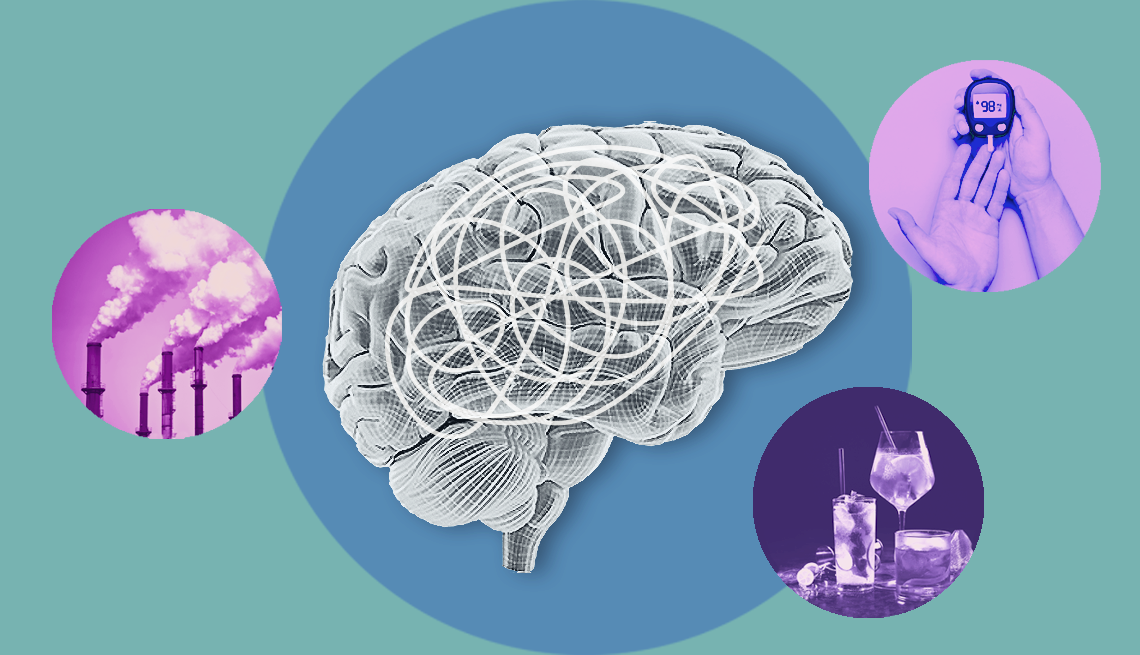
3 big risk factors for dementia
- Select a language for the TTS:
- UK English Female
- UK English Male
- US English Female
- US English Male
- Australian Female
- Australian Male
- Language selected: (auto detect) - EN
Play all audios:

While there are a few risk factors for dementia that you can’t control — like age and family history — a growing body of research shows that there are several that can potentially be changed
throughout life. And a recent study suggests that three of these so-called modifiable risk factors may have a big impact on an aging brain. Diabetes, alcohol consumption (measured by
frequency) and exposure to air pollution are the most harmful modifiable risk factors for dementia out of 15 that were studied in a recent report published in the journal _Nature
Communications_. A team of researchers examined brain scans of nearly 40,000 UK Biobank participants and found that parts of the brain associated with Alzheimer’s disease, the most common
form of dementia, that are more prone to earlier and accelerated aging were most affected by these three factors. “We know that a constellation of brain regions degenerates earlier in aging,
and in this new study we have shown that these specific parts of the brain are most vulnerable to diabetes, traffic-related air pollution — increasingly a major player in dementia — and
alcohol, of all the common risk factors for dementia,” study coauthor Gwenaëlle Douaud, an associate professor at the University of Oxford, said in a statement. Other known modifiable risk
factors studied were blood pressure, cholesterol, weight, smoking, depression, inflammation, hearing, sleep, socialization, diet, physical activity and education. A CLOSER LOOK AT THE BIG
THREE The study findings are not surprising, says Andrew Bender, a neuroimaging researcher at the Cleveland Clinic Lou Ruvo Center for Brain Health. Excessive alcohol use — defined as more
than 21 drinks weekly — is among the 12 modifiable risk factors for dementia noted in a 2020 report published by the _Lancet_ Commission. The Centers for Disease Control and Prevention
(CDC) says that over time, too much alcohol can lead to learning and memory problems, including dementia. And Bender, who was not involved in the latest study, says “diabetes is a really
well studied and well known risk factor.” If diabetes is not well controlled and too much sugar remains in the blood, it can damage the organs over time, including the brain, explains the
Alzheimer’s Association. High blood sugar is also linked to inflammation and cardiovascular disease — both of which can contribute to declining brain health. Research on the health effects
of air pollution is newer, but has been accumulating in recent years. A 2023 study published in _JAMA Internal Medicine_ looked at data from more than 27,000 adults older than 50 and found
that those who went on to develop dementia were more likely to live in places with higher levels of fine particulate matter. This type of air pollution can come from vehicles and factories,
though in this particular study, fine particulate matter from agriculture and wildfires was specifically associated with an increased risk of dementia. Long-term exposure to wildfire smoke
seems to be especially bad for brain health, according to a 2024 study published in the journal _JAMA Neurology_. A team of researchers analyzed the health care records of 1.2 million
Southern California residents aged 60 and older and found that people who were exposed to higher levels of wildfire smoke had a greater risk of developing dementia. Another study published
in 2024 in the journal _Neurology_ found that people with greater exposure to traffic-related air pollution were more likely to have high levels of amyloid plaques in their brains after
they died. These plaques are a hallmark of Alzheimer’s disease. Inflammation could help explain the emerging link between air pollution and brain health. Some animal studies suggest that
“there is a relationship between particulate matter in pollution and inflammation in the brain,” Bender says. Researchers have also found that tiny pollution particles — the kind you might
inhale from smoke or exhaust in the air — can circulate in the blood and work their way into the brain, where they may cause direct damage.
